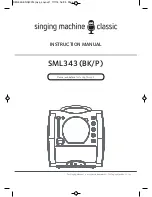
21
Abbreviation
Description
Explanation/Actions
t_aut_max
Maximum external
temperature
Adjustment range upper limit: 15 °C…30 °C
If the external temperature is above the set limit value, the GHE
shutter opens the outdoor air pipe to cool the outdoor air.
→
Cooling
function
t_aut_min
Minimum external
temperature
Adjustment range lower limit: -10 °C…14.5 °C
If the external temperature is below the set limit value, the GHE
shutter opens the outdoor air pipe to heat the outdoor air.
→
Frost
protection function
Table 15: Temperature limit GHE shutter parametrisation
4.3.2.12 Sub-menu Brine defroster cooling
In this menu a potentially present Brine defroster is shown. The cooling function of the brine defroster can be
activated and deactivated. The release of the brine defroster is selected with the navigation buttons (red text
background) and setting a check mark and confirmed via Enter. In addition, the temperature limit for the cooling
function can be selected with the navigation buttons (red background) and adjusted with the +/
- buttons.
Abbreviation
Description
Explanation/Actions
t_sol
Brine cooling
function
temperature limit
Adjustment range: 15 °C…30 °C
If the entering outdoor air temperature at the brine defroster is above
the set limit value, the brine defroster is activated for cooling the
outdoor air.
→
Cooling function
Table 16: Temperature limit brine defroster parametrisation
Boost ventilation mode with external boost ventilation key
Boost ventilation keys are usually installed in rooms from which air is extracted, such as bathrooms, toilets or
kitchens. In this way, maximum ventilation can be activated locally within these rooms for a specific period to enable
rapid extraction of high humidity and odours. When this control module is activated, the functional features and
displays described for the boost ventilation mode with LED control panel or TFT control panel apply. The boost
ventilation mode is restarted each time it is activated and interrupts the current operating mode for the set duration.
Afterwards, the unit reverts to the previously active operating mode. A manual change of the operating mode via
connected control panels stops the boost ventilation function.
Maintenance by the user
For the user, maintenance of the ventilation unit and system is limited to replacing the filters periodically and cleaning
the supply and extract air valves. The filters should be inspected every three months. Filter replacement should be
carried out as necessary, but no later than once every six months.
As part of this process, please inspect the other filters in the ventilation system and replace them if necessary. The
filter mats on the extract air valves (e.g. bathroom, kitchen, WC) should be replaced or cleaned every 2–3 months or
when checking the degree of contamination at one's own discretion.
If the maintenance work is not carried out regularly, this will affect the functionality of the comfort
ventilation system in the long run!
Replacing the unit filters
The system must not be operated without filters. During filter replacement and maintenance work, the
ventilation unit must remain switched off!
Two high-quality original filters from the manufacturer are installed in the FOCUS unit. The filters in the FOCUS unit
must be inspected following the respective message of the control panel or after display of a programmed digital
output signal. In doing so, proceed as follows:
1. Set the unit to the standby mode or disconnect it from the mains.
2. Press the two snap fasteners
A
on the bottom of the unit.
Summary of Contents for FOCUS 200 Base
Page 1: ...Translation of the original instruction manual Heat Recovery Unit FOCUS F 200...
Page 49: ...49 Dimensions Fig 43 Dimensional drawing FOCUS...
Page 50: ...50 FOCUS circuit plan Fig 44 Terminal assignment circuit diagram FOCUS...
Page 51: ...51 Master Controller terminal assignment Fig 45 Master Controller terminal assignment...
















































